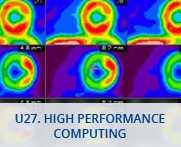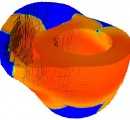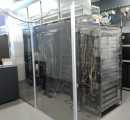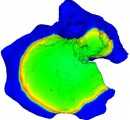U27. High Performance Computing
Located at the Aragon Institute of Engineering Research (I3A), an Interdisciplinary University Research Institute specialized in engineering of the University of Zaragoza, this HPC service counts with a conditioned room to host a cluster of computers that allows remote access for High Performance Computing, massive storage and different software applications for the research in four divisions: Biomedical Engineering, Information and Communications Technologies Division, Processes and Recycling Division and Industrial Technology Division. This Unit is coordinated by Prof. Pablo Laguna, PI of the Biomedical Signal Interpretation & Computational Simulation Groups (BSICoS). FOR THOSE SERVICES IDENTIFIED AS OUTSTANDING, AT LEAST 20% OF THEIR CAPACITY IS OPEN UNDER COMPETITIVE ACCESS. SEE ANNEX 1 OF ACCESS PROTOCOL FOR DETAILS ON % OF OPENNESS FOR EACH SERVICE
10 Feb Interview with Esther Pueyo Paules on her research in cardiac signal processing, computational modeling, and the challenges of balancing science and life. Zaragoza, febrero 2025. As part of our commitment to showcasing outstanding research within the NANBIOSIS network, we are pleased to present an interview with Esther Pueyo Paules, a biomedical engineer specializing in signal processing and computational simulation. She is a researcher at the “Biomedical Signal Interpretation and Computational Simulation” group within the Instituto Universitario de Investigación en Ingeniería de Aragón (I3A, UNIZAR), where NANBIOSIS Unit 27 is integrated. “Scientific research is fascinating”Esther Pueyo A Passion for Scientific Researc[...] 18 Dec The BSICoS research group (Unit 27 of NANBIOSIS) shared 4 years of heart failure data from 1,000 patients on the Physionet portal for scientific use. Zaragoza, December 2024. The BSICoS research group (Biomedical Signal Interpretation and Computational Simulation) from the Aragón Institute of Engineering Research (I3A), in whcih the Unit 27 of NANBIOSIS is located, has shared a clinical database containing information from 992 heart failure patients. These patients underwent a 24-hour electrocardiogram (ECG) recording and were monitored over a four-year period. This dataset enables advancements in research on predicting the risk of sudden cardiac death using Holter monitoring data.[...] 08 Mar Our interview series delve into the journeys of 7 female researchers, their challenges, and the call for gender equality in science, inspiring the next generation. March 8th 2024, NANBIOSIS (Spain) Kicking off on 11F “International Day of Women and Girls in Science” 2024, and spanning all the way until Woman’s Day 2024, our interview series has aimed to highlight the life, career and opinions of some of the brilliant minds within our network. Today is time to wrap it up, and for this reason we present you a summary of each of them and a chance to take a deeper[...] 04 Mar Dr. Mincholé discusses cardiac risk assessment, gender challenges in science, and the transformative potential of Digital Twins in healthcare research. This is part of a series of interviews to several female researchers within the context of International Day of Women and Girls in Science 2024 and Woman’s Day 2024. For more interviews, visit our news section here. March 2024, I3A-Unizar, Zaragoza (Spain) The meeting room of the High Performance Computing cluster is a comfortable place. A whiteboard full of diagrams occupies a good portion of one of the side walls, creating a welcoming atmosphere where complex concepts become accessible. In[...] 11 Nov Researchers of two NANBIOSIS units success in the Third Millennium Awards: the Young Research Talent award to Julia Ramirez (NANBIOSIS U27) and the Research and Future Award to the NFP group (NANBIOSIS U9) Last November 8, four initiatives received the highest award in the eighth edition of the HERALDO contest Third Millennium Awards which represent the recognition of the Aragonese community from the youngest to the most consolidated trajectories in knowledge transfer, innovation, and scientific dissemination. The Paraninfo of the University of Zaragoza hosted this event in which researchers CIBER-BBN – NANBIOSIS were recognised this year: The Films and Nanostructured[...] 02 Mar Esther Pueyo, member of the BSICoS group, which coordinates NANBIOSIS U27 “High Performance Computing” from CIBER-BBN and I3A-UZ, participes with Lina Badimon, professor at the CSIC and group leader at the CIBERCV in the first of a series of videos where two women scientists share their experiences, prepared by the Scientific Culture and Innovation Unit (UCC+i) of the CIBER Both researchers work in the field of Cardiology and share their passion for science and their vocation to help patients. In this video they talk in depth about their career, their difficulties, their achievements, and what their vision is about t[...] 08 Feb The International Day of Women and Girls in Science on February 11 honor women’s significant achievements in science and place a much-needed focus on girls entering Science, Technology, Engineering, and Mathematics (STEM) careers. We want to take this day to congratulate all the women scientists, especially to our scientists at NANBIOSIS ICTS. In this occasion we want to put the spotlight on Raquel Bailon, researcher of Bsicos Group coordinating NANBIOSIS Unit 27 of High-Performance Computing form CIBER-BBN and University of Zaragoza-I3A, who last month has been highlighted by Inside Signal Processing Newsletter. In the interview Dr. Raquel Bailon talks about her motivations[...] 15 Oct Zaragoza, October 14th, 2021 Bsicos.i3a.es Pablo Laguna, Scientific Director of NANBIOSIS U27 High Performance Computing and researcher of BSICoS Group of I3A-UNIZAR and CIBER-BBN gave a talk about Physiologically driven biomedical signal processing at the Faculty of Physics at the Autonomous University of San Luis Potosí (UASLP) in Mexico. He explaned how biomedical signals convey information about biological systems and can emanate from sources of as varied origins as electrical, mechanical or chemical. In particular, biomedical signals can provide relevant information on the function of the human body. This information, however, may not be apparent in the signal due to measurement noise,[...]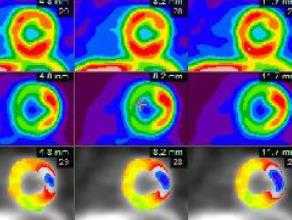

U27. High Performance Computing

Description
Services
Active projects
Other projects
Ref
Title
Funding Organism
Unit Role
T96
BIOMEDICAL SIGNAL INTERPRETATION & COMPUTATIONAL SIMULATION
DGA
Participant
UZCUD2016-TEC-03
Optimization of a submersible device for the monitoring of the photoplestimográfica signal
CUD
Participant
DPI2016-75458-R
MULTI-SCALE PHYSIOLOGY-DRIVEN COMPUTATIONAL TOOLS TO ASSIST IN THE ASSESSMENT AND MANAGEMENT OF CARDIAC DYSFUNCTIONS
MINECO
Participant
TIN2013-41998-R
THE AUTONOMOUS NERVOUS SYSTEM AS A MODULATOR OF CARDIAC FUNCTION: INTEGRAL RESEARCH THROUGH SIGNAL PROCESSING AND COMPUTATIONAL MODELING
MINECO
Participant
Publications
News U27

Interview with Esther Pueyo: Studying the Heart with latest Bioengineering

New Database Provides Valuable Insights into Predicting Sudden Cardiac Death and Atrial Fibrillation
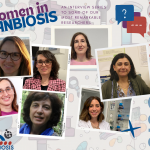
The revolutionary path of research in NANBIOSIS and advice on Woman’s Day 2024

Women in NANBIOSIS part 6: A conversation with Ana Mincholé on unlocking the heart’s secrets

Researchers of two NANBIOSIS units success in the Third Millennium Awards

Conversations with women scientists: Cardiology

Women in Signal Processing: Raquel Bailón
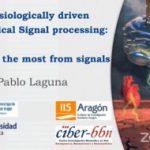
Pablo Laguna talking about Physiologically driven biomedical signal processing at the Autonomous University of San Luis Potosí
